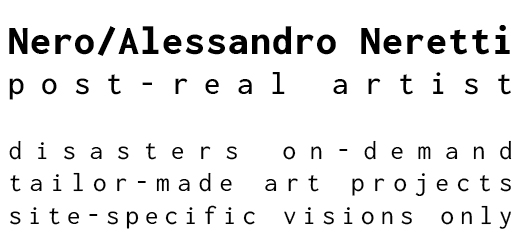Project for AMAA Collaborative Architecture Office For Research And Development
in Dangerous liaisons
at 18th International Architecture Exhibition of La Biennale di Venezia
curated by Lesley Lokko
Arsenale – Venice
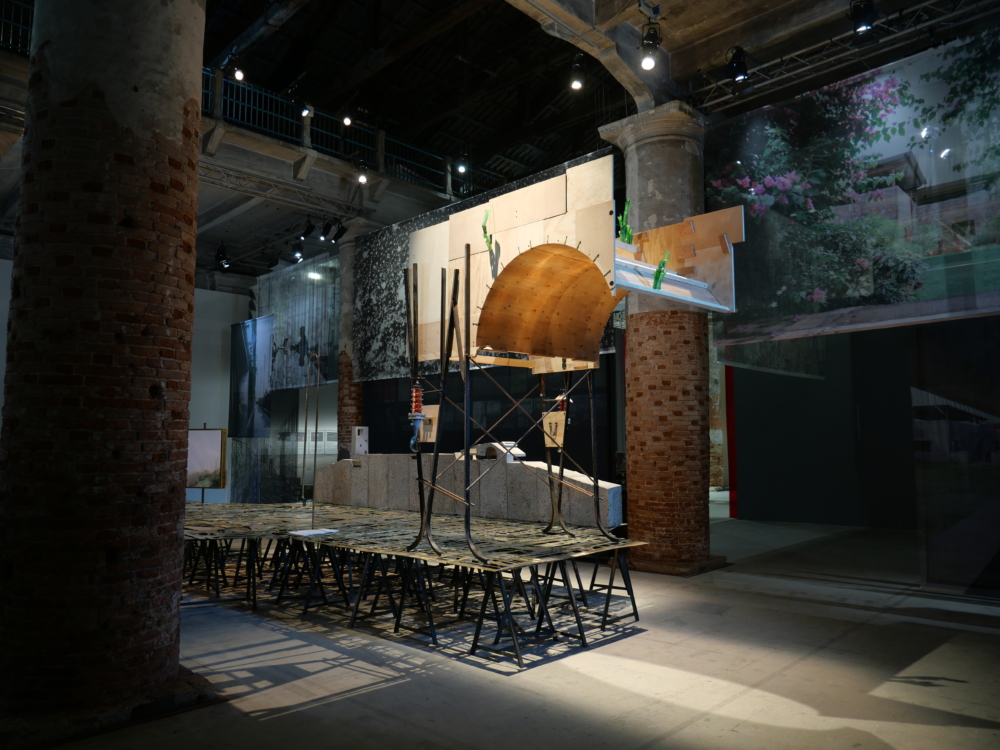
capriccio from ruins (that time the hills dropped into the lagoon), 2023
reversed fence posts and glass insulators from the NATO Base Calvarina, salvaged wood provided by Rebiennale | R3B from the previous edition of the Venice Biennale 2022, scrap iron from German Pavilion – Biennale 2023, ancient terracotta fragments and glass bottle necks salvaged from a cove in Venice, brass from old architectural models from AMAA and from the discards of DeCastelli’s production /
pali di recinzione rovesciati e isolatori in vetro dalla Base NATO Calvarina, legno di recupero fornito da Rebiennale | R3B dalla precedente edizione della Biennale di Venezia 2022, elementi in ferro dal Padiglione Tedesco – Biennale 2023, antichi frammenti di terracotta e colli di bottiglia in vetro recuperati da una cala di Venezia, ottone da vecchi modelli architettonici di AMAA e dagli scarti della produzione DeCastelli
cm 318 x 203,5 x 257,5
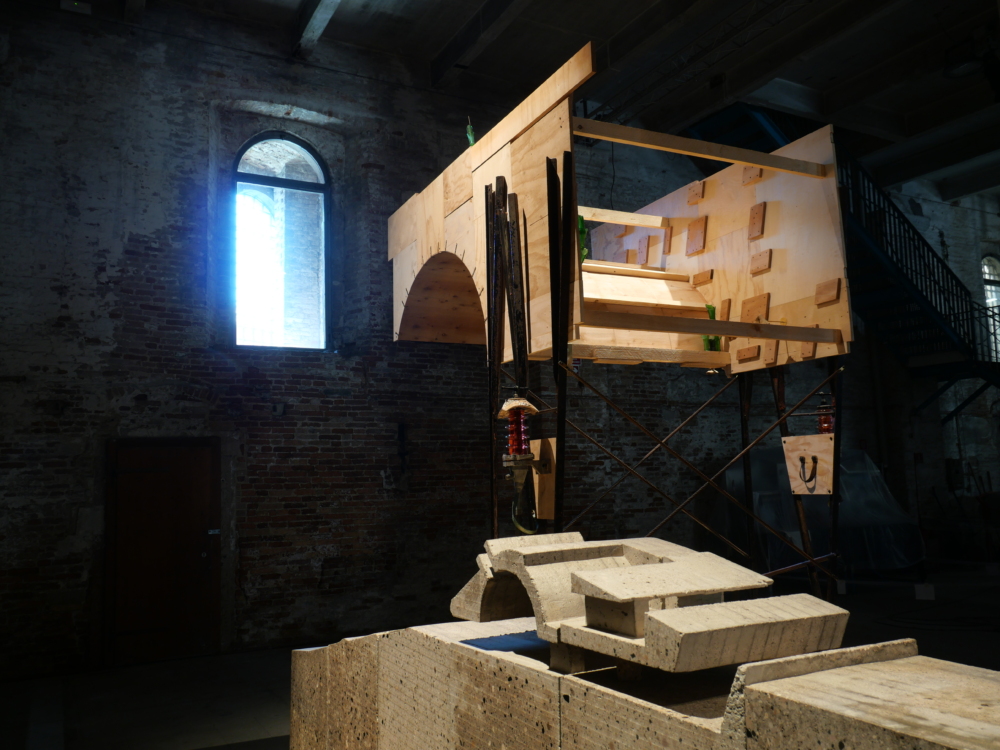
capriccio from ruins (that time the hills dropped into the lagoon) feat. On topography by AMAA
An arch that looks like a starry sky of skin
Marie Achebe
The work presented by Nero for AMAA’s project in Arsenale encapsulates the artist’s most peculiar aptitude: the ability to read the space and ideas hidden within projects and places to transform them into sculptures and installations that satiate the viewer. With this monumental sculpture, created at the Venetian space of Zuecca Projects, Nero combines a series of unusual materials by placing in dialogue distant timelines and two foreign and opposing territories, the hill of the former NATO base in Monte Calvarina (between Vicenza and Verona) and the Venetian lagoon.
The fence posts taken from the military base, deprived of the barbed wire, are turned upside down and assembled, joining the iron rods from the carpentry of the German Pavilion (Biennale 2023), the wooden upper part was instead recovered from the Biennale 2022 installations thanks to the staff of R3B | Rebiennale, on the sides, anchored outdoors, we find two insulators from the electrical compartment of the former NATO base.
Nero, in this project as in others, recuperates and plunders. In AMAA’s Venetian studio, he takes brass from the very first architectural models, machining it and transforming it into perforated plates, washers and custom-made joints.
Concluding the intervention, with poetry and reason, are a series of elements that are, to say the least, dreamlike, which Nero recovered, also in the lagoon, by lowering himself from a wall, thus reaching a small beach that of man has been welcoming debris for years. As always, as a prospector, archaeologist of the recent and the next, he collects and preserves ancient fragments of terracotta (sometimes engulfed and graffitied, others smoked and corroded) and glass bottlenecks, cracked and eroded by the lapping, among sand and small stones.
With the finding of the latter terracotta elements, he creates a kind of small museum in the open part of the structure, forcing the viewer to turn his head upward, among small counterpoints and âgée set and supported among molded brass; while the green glass ends up becoming floral elements, weeds, precariously perched atop the arch.
Bold and pleasing is the choice of Nero, a longtime talented maker of precious ceramics, not to include newly produced elements in this project, unceremoniously following curator Lesley Lokko’s indications that she hoped for the development of the theme of decarbonization.
Capriccio from ruins (that time the hills dropped into the lagoon) takes its cue from the “capriccio with ruins” that made Francesco Guardi famous in the 1700s, which Nero restores to us in this work with his classic play on words that turns with into from, indicating that from ruins and forgotten-and transformed-objects this impressive sculpture was composed.
Un arco che sembra un cielo stellato di pelle
Marie Achebe
L’opera presentata da Nero per il progetto di AMAA in Arsenale racchiude la più peculiare attitudine dell’artista: il saper leggere lo spazio e le idee nascoste dentro i progetti e nei luoghi per trasformare il tutto in sculture ed installazioni che saziano lo spettatore.
Con questa monumentale scultura, realizzata presso lo spazio veneziano di Zuecca Projects, Nero unisce una serie di materiali inusuali ponendo in dialogo linee temporali distanti e due territori estranei e contrapposti, la collina della ex base NATO in Monte Calvarina (tra Vicenza e Verona) e la laguna veneziana.
I pali della recinzione prelevati dalla base militare, privati del filo spinato, vengono capovolti ed assemblati, unendosi ai tondini in ferro da carpenteria del Padiglione della Germania (Biennale 2023), la parte superiore in legno é stata invece recuperata degli allestimenti della Biennale 2022 grazie allo staff di R3B | Rebiennale, sui lati, ancorati in esterno, troviamo due isolatori del comparto elettrico della ex base NATO.
Nero, in questo progetto come in altri, recupera e saccheggia. Nello studio veneziano di AMAA preleva l’ottone dei primissimi modelli architettonici lavorandolo e trasformandolo in piastre forate, rondelle e giunti su misura.
Concludono l’intervento, con poesia e ragione, una serie di elementi a dir poco onirici, che Nero ha recuperato, anch’essi in laguna, calandosi da un muro, raggiungendo così una piccola spiaggia che dell’uomo accoglie da anni i detriti. Come sempre, come un cercatore, archeologo del recente e del prossimo, raccoglie e conserva antichi frammenti di terracotta (a volte ingobbiati e graffiti, altre affumicati e corrosi) e colli di bottiglie di vetro, spaccati ed erosi dallo sciabordio, tra sabbia e piccoli sassi.
Con il ritrovamento di questi ultimi elementi in terracotta crea una sorta di piccolo museo nella parte aperta della struttura, che impone all’osservatore di volgere la testa verso l’alto, tra piccoli contrappunti e âgée incastonati e sorretti tra ottone modellato; mentre i verdi vetri finiscono per diventare elementi floreali, erbacce, precariamente arroccate in cima all’arco.
Ardita e piacevole, la scelta di Nero, da tempo talentoso produttore di preziose ceramiche, di non inserire degli elementi di nuova produzione in questo progetto, seguendo senza troppi problemi le indicazioni della curatrice Lesley Lokko che auspicava il tema della decarbonizzazione.
Capriccio from ruins (that time the hills dropped into the lagoon) prende spunto dai “capricci con rovina” che hanno reso famoso Francesco Guardi nel 1700, che Nero ci restituisce in quest’opera con un suo classico gioco di parole che trasforma il con in da, indicandoci che da rovine ed oggetti dimenticati – e trasformati – questa imponente scultura é stata composta.
making of: caprice from ruins (that time the hills dropped into the lagoon), 2023
an unsolicited and self-produced video for AMAA with music by Andrea Nonni
shot between Zuecca Projects and l’Arsenale /
un video non richiesto e autoprodotto per AMAA con musiche di Andrea Nonni
girato tra Zuecca Projects e l’Arsenale
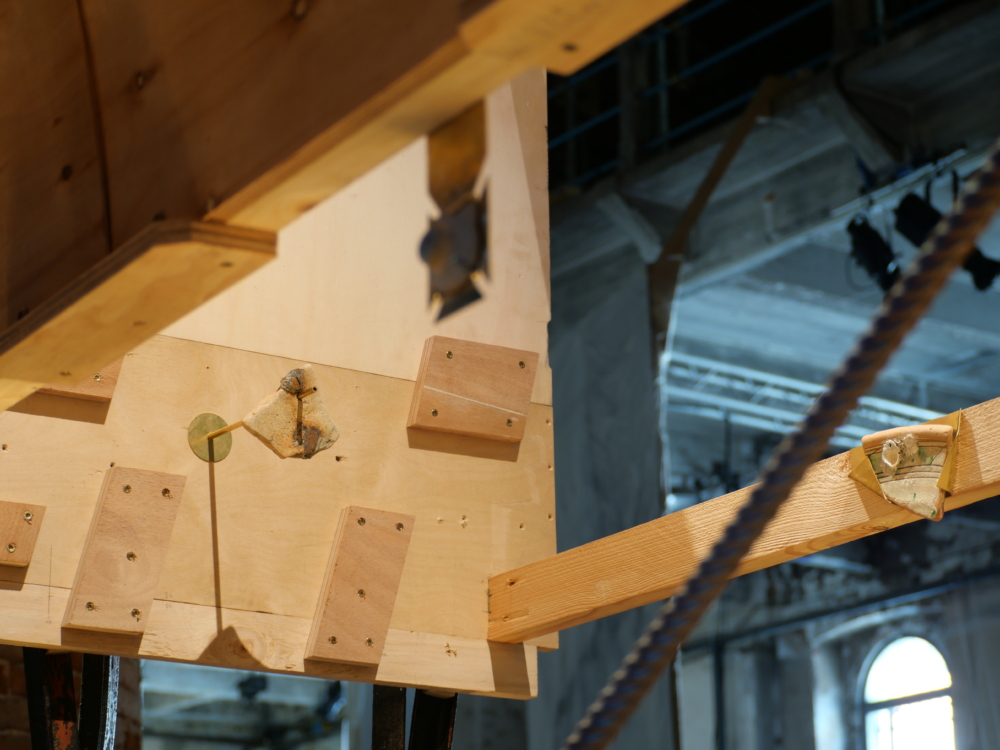
detail from: capriccio from ruins (that time the hills dropped into the lagoon), 2023
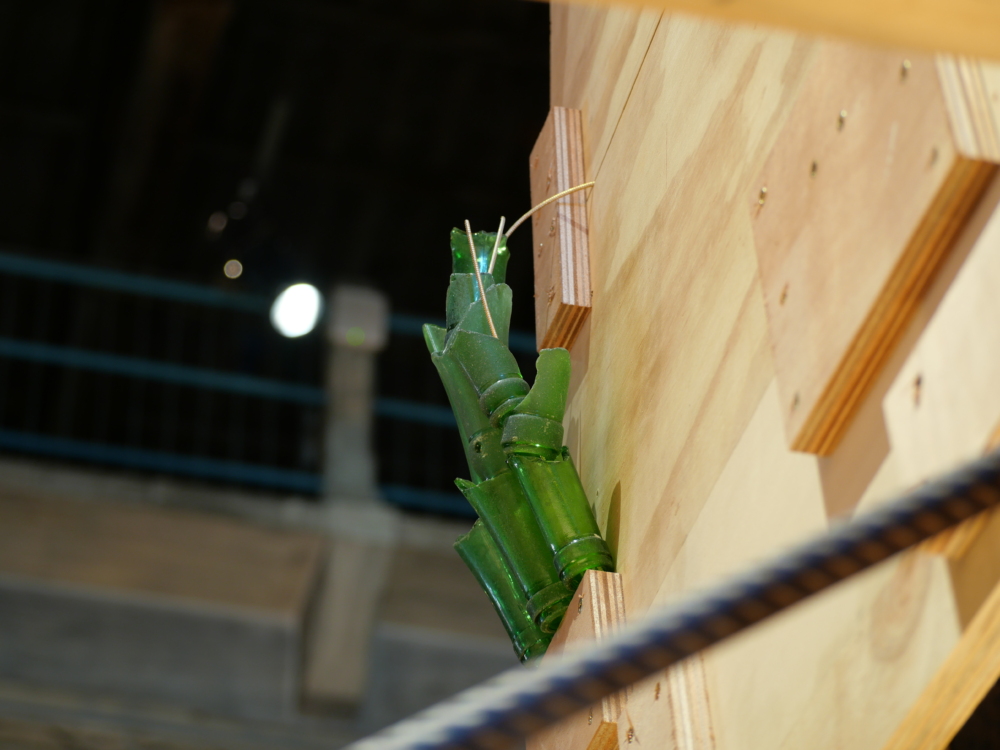
detail from: capriccio from ruins (that time the hills dropped into the lagoon), 2023
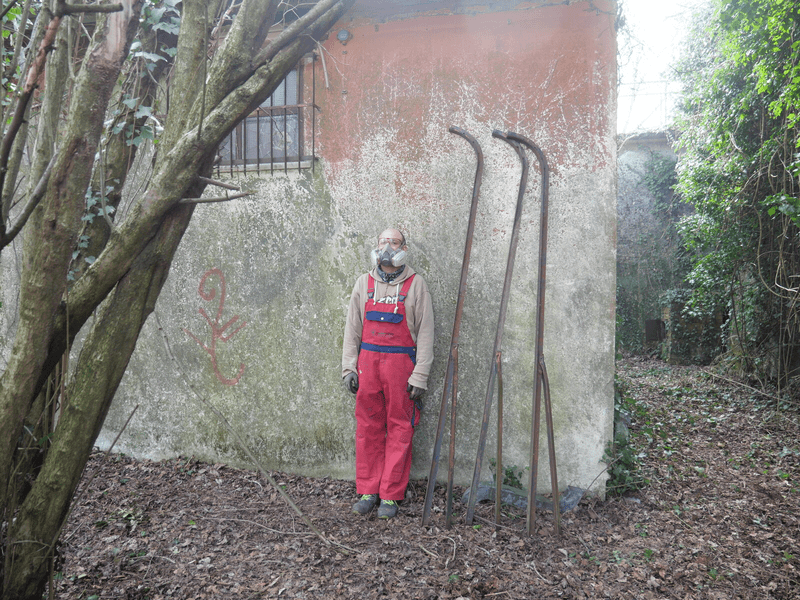
Nero during the second survey and subsequent selection and collection of material at NATO Base Calvarina /
Nero durante il secondo sopralluogo e la successiva selezione e raccolta di materiale presso la Base NATO Calvarina
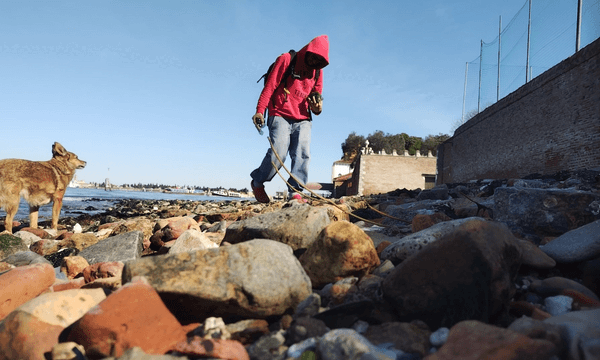
Nero while collecting bottle necks and ancient terracotta in a small cove in Venice /
Nero durante la raccolta di colli di bottiglia e antiche terracotta in una piccola cala a Venezia

detail from the studio table: Article “La clinica dei monumenti – Gli illustri malati di Venezia”* by Gaetano Moretti (Venice, 29 March 1905) in LA LETTURA (May, year V, number 5), bottle necks and ancient terracotta fragments recovered from a small beach at Venice, rabbit skull from Certosa Island, shaped brass
*The Monuments Clinic – The Illustrious sicks of Venice /
particolare del tavolo dello studio: articolo “La clinica dei monumenti – Gli illustri malati di Venezia” di Gaetano Moretti (Venezia, 29 marzo 1905) in LA LETTURA (maggio, anno V, numero 5), colli di bottiglia e frammenti di terracotta antica recuperati da una spiaggetta di Venezia, teschio di coniglio dall’Isola della Certosa, ottone modellato
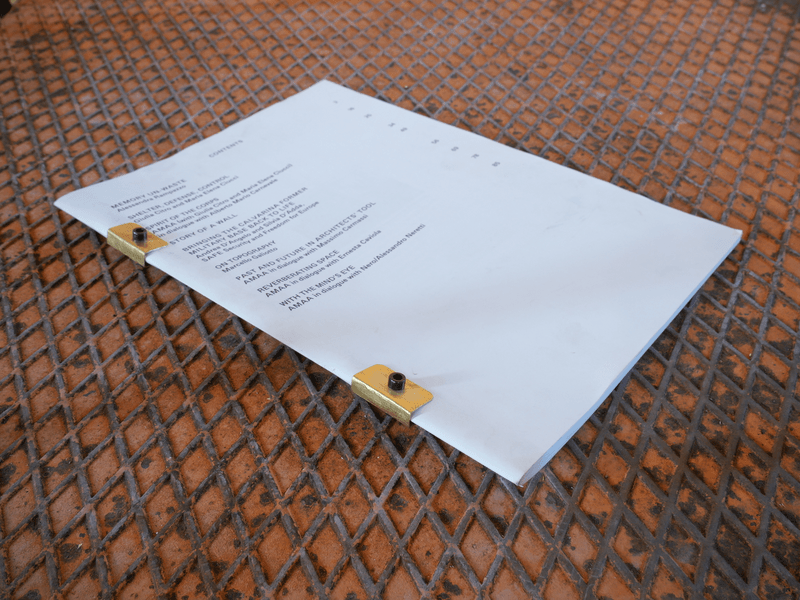
hand made recycled brass clamps for the AMAA book /
morsetti in ottone riciclato fatti a mano per il libro AMAA
QUICK BIO
Italy, 1980. Visual artist and critical observer of the contemporary condition, he extends a constant work of auto-fiction to environmental research that addresses the space of here and now, comprising architectural, cultural, and natural values. The processes of self-definition and re-elaboration of the sensitive datum are interwoven in highly symbolic images. The end objective is the provocation, the resistance, and the alternative to historical and cultural collapse.
Some of his solo projects were hosted by Mart Museum – Rovereto/IT; Museum Beelden aan Zee* – Scheveningen/NL, MAR Museum* – Ravenna/IT; PAC/Padiglione d’Arte Contemporanea – Milan/IT.
In 2023, together with a collective of architects, designers and landscape architects, they won the international competition to design the new TINNE Junges Museum Klausen* in Chiusa/IT; in 2022 he won the ministerial call for proposals PAC for a site-specific project at the Luigi Varoli Civic Museum* in Cotignola/IT; in 2021 he received an Honorable Mention at the Korea International Ceramic Biennale at Gyeonggi Ceramic Museum* in South Korea; in 2020 he was selected through a public call for proposals to acquire a work for the Cultural Heritage Region of Emilia-Romagna*; in 2013 won the First Prize at 58th International Competition of Contemporary Ceramic Art – section under 40, MIC Museum* in Faenza/IT.
*Artwork present in the collection.
BREVE BIO
Italia, 1980. Artista visivo, critico osservatore della condizione contemporanea estende un costante lavoro di auto-fiction alla ricerca ambientale, che si rivolge allo spazio del qui e dell’ora, comprendendo valori architettonici, culturali e naturali. I processi di autodefinizione e di rielaborazione del dato sensibile si intrecciano in immagini fortemente simboliche. L’obiettivo finale è la provocazione, la resistenza, l’alternativa al collasso storico e culturale.
Alcuni dei suoi progetti personali sono stati ospitati da: Mart – Museo di arte moderna e contemporanea – Rovereto, Museum Beelden aan Zee* – Scheveningen/Paesi Bassi, MAR – Museo d’Arte Della Città* – Ravenna, PAC/Padiglione d’Arte Contemporanea – Milano.
Nel 2023, insieme al collettivo di architetti, designer e paesaggisti, vince in RTP il concorso internazionale per la progettazione del nuovo “TINNE giovane museo chiusa” a Chiusa*; nel 2022 risulta vincitore del bando ministeriale “PAC – Piano per l’Arte Contemporanea” per la realizzazione di una serie di nuove sculture site-specific presso Museo Civico Luigi Varoli a Cotignola*; nel 2021 viene insignito della Menzione d’Onore alla Korea International Ceramic Biennale, Gyeonggi Ceramic Museum* – Gwangju/Repubblica di Corea; nel 2020 una sua opera viene selezionata tramite bando pubblico dalla regione Emilia-Romagna per essere acquisita nel Patrimonio Culturale della Regione*; 2019 vince il Primo Premio al 26° Concorso di Ceramica Contemporanea, Museo di Grottaglie; nel 2013 vince il Primo Premio al 58° Concorso Internazionale della Ceramica d’Arte Contemporanea – sezione under 40, Museo Internazionale delle Ceramiche* di Faenza.
*Opera d’arte presente in collezione.
Partner: Zuecca Projects and
Rebiennale | R3B
